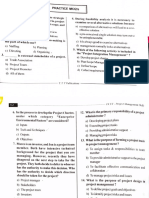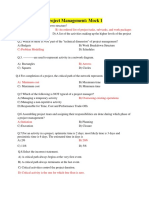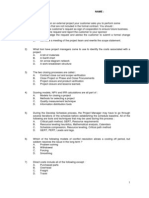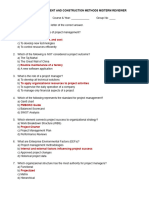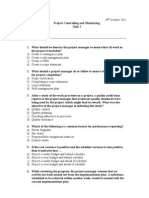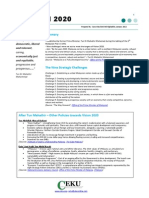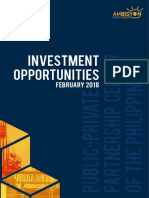0 ratings0% found this document useful (0 votes)
17 viewsUniversity of Calicut School of Distance Education Bba Semester Vi
University of Calicut School of Distance Education Bba Semester Vi
Uploaded by
Hanan HanThe document contains a question bank with 37 multiple choice questions related to project management topics. The questions cover concepts like project life cycles, feasibility studies, traditional and modern project appraisal methods, and key project management terms. The document provides an assessment tool to test knowledge of fundamental project management principles.
Copyright:
© All Rights Reserved
Available Formats
Download as PDF, TXT or read online from Scribd
University of Calicut School of Distance Education Bba Semester Vi
University of Calicut School of Distance Education Bba Semester Vi
Uploaded by
Hanan Han0 ratings0% found this document useful (0 votes)
17 views11 pagesThe document contains a question bank with 37 multiple choice questions related to project management topics. The questions cover concepts like project life cycles, feasibility studies, traditional and modern project appraisal methods, and key project management terms. The document provides an assessment tool to test knowledge of fundamental project management principles.
Original Description:
A paper
Original Title
5_6147741416408745480
Copyright
© © All Rights Reserved
Available Formats
PDF, TXT or read online from Scribd
Share this document
Did you find this document useful?
Is this content inappropriate?
The document contains a question bank with 37 multiple choice questions related to project management topics. The questions cover concepts like project life cycles, feasibility studies, traditional and modern project appraisal methods, and key project management terms. The document provides an assessment tool to test knowledge of fundamental project management principles.
Copyright:
© All Rights Reserved
Available Formats
Download as PDF, TXT or read online from Scribd
Download as pdf or txt
0 ratings0% found this document useful (0 votes)
17 views11 pagesUniversity of Calicut School of Distance Education Bba Semester Vi
University of Calicut School of Distance Education Bba Semester Vi
Uploaded by
Hanan HanThe document contains a question bank with 37 multiple choice questions related to project management topics. The questions cover concepts like project life cycles, feasibility studies, traditional and modern project appraisal methods, and key project management terms. The document provides an assessment tool to test knowledge of fundamental project management principles.
Copyright:
© All Rights Reserved
Available Formats
Download as PDF, TXT or read online from Scribd
Download as pdf or txt
You are on page 1of 11
UNIVERSITY OF CALICUT
SCHOOL OF DISTANCE EDUCATION
BBA SEMESTER VI
(2019 Admn. Onwards)
CORE COURSE
BBA6B14 – PROJECT MANAGEMENT
QUESTION BANK
1. The basic nature of a project is a/an _____ one.
a) permanent b) temporary
c) a or b d) Both a & b
2. A process that involves continuously improving and detailing a plan as more detail become
available is termed as
a) project analysis b) project enhancing
c) progressive deliberation d) progressive elaboration
3. A program is usually a group of
a) plans b) people and work
c) related projects d) unrelated projects
4. The process each manager follows during the life of a project known as
a) Project management b) Manager life cycle
c) Project management life cycle d) All of the above
5. Which of the following is not a goal of project management.
a) Keeping overall costs within budget
b) Delivering the software to the customer at the agrees time
c) Marinating a happy and well-functioning development team
d) Avoiding customer complaints
6. Project performance consists of
a) Time b) Cost
c) Quality d) All of these
7. Following is (are) the responsibility (ies) of the project manager.
a) Budgeting and cost control b) Allocating resources
c) Tracking project expenditure d) All of these
8. A ____ is a set of activities which are networked in an order and aimed towards achieving
the goals of a project.
a) Project b) Process
c) Project management d) Project cycle
9. In which of the following stages are project objectives established, teams formed, and major
responsibilities assigned?
a) Conceptualizing b) Defining
c) Planning d) Executing
10. In which of the following stages is a major portion of the physical and mental project work
performed?
a) Conceptualizing b) Defining
c) Planning d) Executing
11. Which of the following choices is not one of the stages of a project life cycle?
a) Conceptualizing b) Defining
c) Planning d) Executing
12. Two dimensions within the project management process are
a) Technical and sociocultural b) Cost and time
c) Planned and unexpected d) Established and new
13. The payback period for a project
a) is the initial fixed investment in the project divided by the estimated annual net cash
inflows from the project.
b) is the discounted cash flow method determines the net present value of all cash flows
by discounting them by the required rate of return.
c) also known as the benefit–cost ratio.
d) the internal rate of return is the discount rate that equates the present values of the
two sets of flows.
14. Expand SCBA
a) Social Cost Benefit Analysis b) Social Cost Beneficiary Analysis
c) Society Cost Benefit Analysis d) Social Cost Benefit Amount
15. A project would normally be undertaken if its Net Present Value (NPV) is
a) Exactly the same as the NPV of the existing project b) negative
c) positive d) zero
16. Advantage of Profitability model is
a) Models that do not include discounting ignore the timing of the cash flows and the
time–value of money.
b) Payback-type models ignore cash flows beyond the payback period.
c) All use readily available accounting data to determine the cash flows.
d) All are sensitive to errors in the input data for the early years of the project.
17. Expand IRR
a) Internal Rate of Return b) Internal Risk & Return
c) Interim Rate of Return d) Integral Rate of Return
18. Expand NPV
a) Net Present Value b) National Present Value
c) Net Present Volume d) Net Prime Value
19. Which of the following method is not a traditional method of project appraisal?
a) NPV b) ARR
c) Payback period d) Urgency method
20. Which of the following is not a modern method of project appraisal?
a) NPV b) IRR
c) Payback period d) PI method
21. Average Rate of Return method is also called as
a) Accounting Rate of Return Method b) Return on Investment Method
c) Unadjusted Rate of Return Method d) All of these
22. ARR method of project appraisal is a __________ method
a) Modern b) Traditional
c) Both of these d) None of these
23. PI method is also called
a) Benefit Cost Ratio b) Return on Investment Method
c) Unadjusted Rate of Return Method d) None of these
24. Modern method of Project appraisal are also called as
a) Discounting Techniques b) Non Discounting techniques
c) Unadjusted Rate of Return Method d) None of these
25. Traditional methods of Project appraisal are also called as
a) Discounting Techniques b) Non Discounting Techniques
c) Unadjusted Rate of Return Method d) None of these
26. The process of determining whether the project idea is a viable foundation for creating a
successful business is known as a:
a) feasibility analysis b) business plan
c) strategic analysis d) industry analysis
27. Which of the following is included in feasibility study?
a) Financial Feasibility b) Physical Feasibility
c) Demographic Feasibility d) Resources Feasibility
28. Which of the following among is the aspects of technical feasibility study?
a) Demand b) Location
c) Security d) Instruction
29. The accounting rate of return is measured as follows:
a) Average annual profit expressed as a percentage of the total funds invested in the
project
b) Average annual profit expressed as a percentage of the average funds invested in the
project.
c) Total profits expressed as a percentage of the average funds invested in the project.
d) Total profits expressed as a percentage of the total funds invested in the project.
30. Which of the following statements concerning the NPV is not true?
a) The NPV technique takes account of the time value of money
b) The NPV of a project is the sum of all the discounted cash flows associated with a
project.
c) The NPV technique takes account of all the cash flows associated with a project
d) If two competing projects are being considered, the one expected to yield the lowest
NPV should be selected.
31. What should be done by the project manager to ensure that all the work in the project
is included?
a) Create a contingency plan b) Create a risk management plan
c) Create a WBS d) Create a statement of work
32. A good project management system provides for defining the interface between the project
team and the organization in all the following areas except
a) Authority
b) Allocation of resources
c) Development of project team members
d) Integration of the project into the organization
33. The method used to collect information to use through all phases of the project life cycle is
called
a) Responsibility matrix b) Organization breakdown structure
c) Work breakdown structure d) Priority matrix
34. The first step in creating the necessary information to manage a project is to
a) Establish project priorities b) Define the project scope
c) Verify the budget available d) Assign team members to work on the project
35. The tendency for the project deliverables to expand over time-usually by changing
requirements, specifications, and priorities-is called:
a) Scope erosion b) Scope creep
c) Project bloat d) Project add-ons
36. The process of forecasting or approximating the time and cost of completing project
deliverables is called
a) Budgeting b) Predicting
c) Estimating d) Planning
37. Which of the following is NOT an input to the initiating process group?
a) Company processes b) The company culture
c) Historical WBSs d) Project scope statement
38. A person who is involved in or may be affected by the activities or anyone who has
something to gain or lose by the activity of the project is called a:
a) Team member b) Customer
c) Stakeholder d) Supporter
39. Which of the following is an advantage of including the project manager in the project
evaluation process?
a) It enables the project manager to have an understanding of the selection criteria
that can be used when making decisions about the project during later phases.
b) It may indicate a need for project manager skills and experiences that are
different from the project manager who is involved in the evaluation.
c) It allows the parent organization to select a project manager whose abilities
match the complexity profile of the project.
d) It helps achieve greater buy-in from the top management of the parent
organization.
40. __________ offers their owners preferences over ordinary shareholders.
a) Equity Shares b) Preference Shares
c) Debentures d) None of these
41. Who are the true owners of the Company?
a) Equity Shares b) Preference Shares
c) Debentures d) None of these
42. Which is the cheapest equity source of capital?
a) Preference Share Capital b) Working Capital
c) Retained Earnings d) Both a and b
43. SIDCs stands for
a) State Infrastructural Development Corporation
b) State Industrial Development Corporation
c) State Investment Development Corporation
d) None of the above
44. Pre-requisite to project finance includes:
a) Sustainable Economics b) Accessible Financing
c) Political Stability d) All of these
45. The expenses that are incurred during the commencement of commercial production are
referred to as __________.
a) Preliminary expenses b) Pre-operative expenses
c) Miscellaneous expenses d) Capital issue expenses
46. When the banks or financial institutions are asked to participate in the scheme of finance,
the promoters should bring _________ % of the project cost into the equity share capital of the
company.
a) 10 to 25 b) 25 to 30
c) 30 to 50 d) 100
47. The capital provided by outside inventors for financing of new, innovative or struggling
business are termed as ________.
a) Equity capital financing b) Preference capital financing
c) Venture capital financing d) None of these
48. The agreement between lesser and lessee is called
a) Hire purchase b) Leasing
c) Venture capital financing d) Debt financing
49. Which is the very ancient source of financing short term funds?
a) Trade credit b) Hundies
c) Factoring d) Commercial Papers
50. Preliminary expenses includes the expenses incurred for
a) Identifying the project b) Conducting the market survey
c) Preparing the feasibility report d) All of these
51. Sources of equity financing includes:
a) Retained Earnings b) Preference Shares
c) Equity Shares d) All of these
52. Execution phase includes:
a) Performing required tasks for project
b) Monitoring and Control the performance
c) Both a and b
d) None of the above
53. MIGA stands for
a) Multilateral Investment Guarantee Agency
b) Multilateral Investment Guarantee Act
c) Multilateral Industrial Guarantee Agency
d) Multilateral Industrial Guarantee Act
54. _________ involves collecting, processing and communicating information to key
stakeholders, regarding the performance of the project.
a) Progress Reporting b) Program Reporting
c) Progress Control d) Performance Reporting
55. Progress Report is a document prepared by
a) Project Team Members b) Equity Share Holders
c) Preference Share Holders d) Top Management
56. Project Synopsis includes:
a) Duration b) Project activities
c) Project Goals and objectives d) All of these
57. Approaches in project implementation does not includes:
a) Parallel b) Phased
c) Pilot d) Diagonal
58. Commercial Papers are
a) Long term source for Working Capital b) Short term source for Working Capital
c) Not a source for Working Capital d) Neither a or b
59. ________ holders have voting rights and right on all the remainder profit after paying
interest to preferential dividends.
a) Equity Share Holders b) Preference Share Holders
c) Debenture holders d) Both a and b
60. Syndicated loan is a form of lending in which _________.
a) A group of lenders collectively extend a loan to a single borrower
b) A lender extend a loan to group of borrowers
c) A loan made by a single lender to a single borrower
d) A group of lenders collectively extend a loan to group of borrowers
61. You’re working with your project to examine the work packages of the WBS and subdivide
these elements into the project activities. What term is given to this technique?
a) Synergy b) Decomposition
c) Activity definition linking d) Control account plans
62. Risks will be identified during which risk management process (es)?
a) Perform Quantitative Risk Analysis and Identify Risks
b) Identify Risks and Control Risks
c) Perform Qualitative Risk Analysis and Control Risks
d) Identify Risks
63. Who is ultimately responsible for quality management on the project?
a) Project engineer b) Project manager
c) Quality manager d) Team member
64. The project life cycle consists of
a) Understanding the scope of the project
b) Objectives of the project
c) Formulation and planning various activities
d) All of these
65. The entire process of a project may be considered to be made up on number of sub process
placed in different stage called the
a) Technical key resources b) Work key structure
c) Work Breakdown Structure (WBS) d) None of these
66. Following is (are) the component(s) of risk management
a) Risk Assessment b) Risk Control
c) Risk Ranking d) All of these
67. Controlling the changes in the project may affect
a) The progress of the project b) Stage cost
c) Project scope d) All of these
68. In project management, the term quality is best defined as:
a) inspection, testing and measurement b) reviews and audits
c) fitness for purpose of deliverables d) professionally-bound project reports
69. Which one of the following is not considered in resource management?
a) Identifying resources b) Influencing resources
c) Assigning resources to activities d) Matching resources to the schedule
70. The __________ approach, produces the changeover from old system to the new system
instantly.
a) Direct Cutover b) Parallel
c) Pilot d) Phased
71. ___________ approach, is the method in which both the new system and the old system
will operate at the same time, for a specified period of time, in order to check the new system
for complexities.
a) Direct Cutover b) Parallel
c) Pilot d) Phased
72. ________ approach involves implementing the new system at a selected location like a
branch office, one department in a company, etc. and the old system continues to operate for
the entire organization.
a) Direct Cutover b) Parallel
c) Pilot d) Phased
73. ___________ approach allows implementing the new system in phases or modules or
stages in different parts of the organization incrementally.
a) Direct Cutover b) Parallel
c) Pilot d) Phased
74. _____________ might be used as legal evidence if there is a dispute about the outcome of
the project such as a cost overrun.
a) Project Data b) Project Diary
c) Project Statement d) Project Idea
75. The process by which projects are defined, planned, monitored, controlled and delivered
so that agreed benefits are realised called it as ________.
a) Project b) Budget
c) Scheduling d) Production
76. The management of a combination of numerous individual processes, many of which relate
to the subsidiary discipline of project control called it as _______.
a) Project Finance b) Project Management
c) Project Viability d) Project Tool
77. ___________ is the process of monitoring the status of the project to update the project
schedule and managing changes to the schedule baseline.
a) Process Schedule b) Planning Schedule
c) Control Schedule d) Forecasting Schedule
78. Which of the following is not a main source of changes?
a) Organisational b) Environmental
c) Technical d) Political
79. ____________ refers to a lending process wherein a borrower approaches a bank for a loan
amount that is comparatively heavy and also involves international transactions and different
currencies.
a) Lead Bank b) Internal Financing
c) Loan Syndication d) None of these
80. A ____________ is successful where it is not possible for a single bank to finance the loan
amount to the borrower; simply the loan amount is too large or risky for a single lender to
provide.
a) Consortium b) Loan Syndication
c) Lead Bank d) None of these
Answers
1 b 21 d 41 a 61 b
2 d 22 b 42 c 62 b
3 c 23 a 43 b 63 b
4 c 24 a 44 d 64 d
5 d 25 b 45 b 65 c
6 d 26 a 46 c 66 d
7 d 27 a 47 c 67 d
8 a 28 a 48 b 68 c
9 b 29 b 49 b 69 b
10 d 30 d 50 d 70 a
11 a 31 c 51 d 71 b
12 a 32 c 52 c 72 c
13 a 33 c 53 a 73 d
14 a 34 b 54 d 74 b
15 c 35 b 55 a 75 a
16 c 36 c 56 d 76 b
17 a 37 d 57 d 77 c
18 a 38 c 58 b 78 d
19 a 39 a 59 a 79 c
20 c 40 b 60 a 80 a
Prepared by:
Dr. Sudheesh S
Assistant Professor on Contract
SDE, University of Calicut
********
You might also like
- Project Appraisal and ManagementDocument5 pagesProject Appraisal and ManagementMahin uddinNo ratings yet
- Hydro Tariff DeterminationDocument12 pagesHydro Tariff DeterminationAnonymous sENwj8nwq100% (3)
- TEST1Document6 pagesTEST1johanariverafo0% (1)
- MCQ Project ManagmentDocument45 pagesMCQ Project ManagmentAbhishek60% (10)
- PM - REVISED Multiple Choice Questions TodayDocument41 pagesPM - REVISED Multiple Choice Questions TodayAdarsh Rasal100% (4)
- ItlpDocument14 pagesItlpA_saravanavelNo ratings yet
- Economics of Market FailureDocument4 pagesEconomics of Market FailureMithila SeneviratneNo ratings yet
- Amity Assign On Project ManagementDocument7 pagesAmity Assign On Project ManagementAliya ShahNo ratings yet
- PM Soln QBDocument21 pagesPM Soln QBANKITNo ratings yet
- PM Insem Exam Q Bank Unit 1 and 2Document7 pagesPM Insem Exam Q Bank Unit 1 and 2ajyaNo ratings yet
- Project Management Question Bank Cluster 09Document31 pagesProject Management Question Bank Cluster 09rishavrivals23No ratings yet
- Project MGT MCQ Question BankDocument12 pagesProject MGT MCQ Question BankvijayNo ratings yet
- Wa0014Document2 pagesWa0014Pradeep ChandrasekarNo ratings yet
- Examination Paper of - Project Management (Certification)Document14 pagesExamination Paper of - Project Management (Certification)Divyang khatriNo ratings yet
- Project ManagementDocument7 pagesProject ManagementJaveria KhanNo ratings yet
- MCQ S Project ManagementDocument7 pagesMCQ S Project Managementsubash_icfai701180% (10)
- Project ManagementDocument13 pagesProject ManagementTushar TaleNo ratings yet
- Project ManagamentDocument5 pagesProject ManagamentHina Hanif UsmanNo ratings yet
- Chapter 1 Review QuizDocument6 pagesChapter 1 Review QuizFeng DuNo ratings yet
- MGT - Midterm1Document15 pagesMGT - Midterm1Anonymous aTKY5CEQRNo ratings yet
- Project ManagementDocument23 pagesProject Managementsumit sanchetiNo ratings yet
- PM Ch1-MCQDocument33 pagesPM Ch1-MCQCharuJagwaniNo ratings yet
- 100 Sample Questions of MCQ Project ManagementDocument10 pages100 Sample Questions of MCQ Project ManagementmaheshNo ratings yet
- FinalExam ICT481 2018Document8 pagesFinalExam ICT481 2018kaaubrey423No ratings yet
- MIS462-01 Exam #1 Study Questions: 1. A ProjectDocument24 pagesMIS462-01 Exam #1 Study Questions: 1. A ProjectBree ElaineNo ratings yet
- Pms 2 To 5 ChapterDocument15 pagesPms 2 To 5 ChapterVIGNESH SNo ratings yet
- PM Ch1-MCQDocument13 pagesPM Ch1-MCQViŠhål PätělNo ratings yet
- Chapter 1 4 ExamDocument12 pagesChapter 1 4 ExamDrogNo ratings yet
- Mg6088 Software Project ManagementDocument45 pagesMg6088 Software Project ManagementTOM JOSEPHNo ratings yet
- B1S3 Tutorial 1Document24 pagesB1S3 Tutorial 1hninNo ratings yet
- Questions For PMPDocument26 pagesQuestions For PMPWael_Barakat_3179100% (1)
- Project Management: Mock 1: B) An Ordered List of Project Tasks, Sub-Tasks, and Work PackagesDocument51 pagesProject Management: Mock 1: B) An Ordered List of Project Tasks, Sub-Tasks, and Work PackagesDiksha Gangwani100% (1)
- Bench Mark 2 NameDocument29 pagesBench Mark 2 NameShoaib Khot100% (1)
- PMP® - PMBOK® Guide - Sixth Edition - Classroom Test PaperDocument42 pagesPMP® - PMBOK® Guide - Sixth Edition - Classroom Test PaperJithuRaj100% (1)
- MCQs On Project Management PDFDocument14 pagesMCQs On Project Management PDFsonali bhosaleNo ratings yet
- PM REVISED Multiple Choice Questions TodayDocument41 pagesPM REVISED Multiple Choice Questions TodayJyoti SinghNo ratings yet
- Project ManagementDocument17 pagesProject Managementpradeepmenonsree0% (4)
- PM MCQ With AnsDocument41 pagesPM MCQ With AnsJyoti SinghNo ratings yet
- ANSWER KEY for Reviewer 1Document7 pagesANSWER KEY for Reviewer 1Mary Lourdes FerolinNo ratings yet
- BTM 480 Practice Exam Winter Semester 2021Document11 pagesBTM 480 Practice Exam Winter Semester 2021Ahmed KhemiliNo ratings yet
- Management of Engineering Project Final ExamDocument5 pagesManagement of Engineering Project Final ExamAngeleen Nicole LabaoNo ratings yet
- PMP Lesson 8: Name: Class: DateDocument12 pagesPMP Lesson 8: Name: Class: DateYas AlbNo ratings yet
- Project Management Chapter 1 - MCQDocument9 pagesProject Management Chapter 1 - MCQdamionchambers01No ratings yet
- Quiz 1Document2 pagesQuiz 1Malik Ali SabihNo ratings yet
- Exam IpmpDocument10 pagesExam IpmpChukwuemeka Okore IkoroNo ratings yet
- Multiple Choice Questions Chapter 19 Managing ProjectsDocument8 pagesMultiple Choice Questions Chapter 19 Managing ProjectsKevin KmikzeNo ratings yet
- Edwel Mock TestDocument11 pagesEdwel Mock Testtayyabkk17961No ratings yet
- Chapter 14 Review QuizDocument8 pagesChapter 14 Review QuizIftekhar ChowdhuryNo ratings yet
- Self QuizzzDocument9 pagesSelf Quizzzdoannamphuoc100% (1)
- SPM MCQ Model2Document7 pagesSPM MCQ Model2HEMALATHA SHANMUGAMNo ratings yet
- PM TestbankDocument14 pagesPM Testbankngọc nguyễnNo ratings yet
- Project Management (Sem. VIII Institute Elective)Document7 pagesProject Management (Sem. VIII Institute Elective)ANKITNo ratings yet
- Project Management MBADocument5 pagesProject Management MBAIncredible video'sNo ratings yet
- Chapters 1 Thru 8 Review Questions Rev 2Document108 pagesChapters 1 Thru 8 Review Questions Rev 2wilchaNo ratings yet
- Production ManagementDocument14 pagesProduction Managementavinasss1963_3707255No ratings yet
- Mock Exam PMP5Document18 pagesMock Exam PMP5mahati75No ratings yet
- Project IT Management QuestionsDocument23 pagesProject IT Management Questionsحسام الاسبانيNo ratings yet
- MCQDocument6 pagesMCQGaurav KumarNo ratings yet
- Question Bank PM AtulDocument8 pagesQuestion Bank PM AtulMY NAME IS NEERAJ..:):)No ratings yet
- Chapter 1 Framework QuestionsDocument5 pagesChapter 1 Framework Questionsnsadnan75% (4)
- Mid Project Compiled QuestionsDocument14 pagesMid Project Compiled QuestionsgunadiishNo ratings yet
- PPM MCQDocument109 pagesPPM MCQM.t.s.k.tejesh100% (2)
- 202 FM MCQsDocument39 pages202 FM MCQsAK Aru ShettyNo ratings yet
- Loan SyndicationDocument4 pagesLoan SyndicationRalsha DinoopNo ratings yet
- Seatwork6 Withanswer Final PDFDocument2 pagesSeatwork6 Withanswer Final PDFLester John PrecillasNo ratings yet
- Film Insurance in IndiaDocument14 pagesFilm Insurance in IndiaManohar GadreNo ratings yet
- 7p of SbiDocument9 pages7p of SbiMilan PatelNo ratings yet
- Simple InterestDocument4 pagesSimple InterestAkshay KakaniNo ratings yet
- WAWASAN 2020: " Living in A Society That IsDocument2 pagesWAWASAN 2020: " Living in A Society That IsAbdrhman Hisham AzmanNo ratings yet
- Enarcon India Project PlanningDocument11 pagesEnarcon India Project PlanningChetan Panara100% (1)
- Disbursed KFSDocument24 pagesDisbursed KFSamulyabehera1976No ratings yet
- UBL Fund Manager's Report - February 2024Document49 pagesUBL Fund Manager's Report - February 2024aniqa.asgharNo ratings yet
- Pre Market Report 21-10Document8 pagesPre Market Report 21-10piyush.chaudhari0012No ratings yet
- 128201472588519Document3 pages128201472588519Sahadev TyagiNo ratings yet
- Account Statement 24-Aug-2022 19 12 28Document3 pagesAccount Statement 24-Aug-2022 19 12 28saicharanNo ratings yet
- Investment ManagementDocument26 pagesInvestment Managementranveer78krNo ratings yet
- KPJ Healthcare Berhad - Stable Outlook - 190220Document3 pagesKPJ Healthcare Berhad - Stable Outlook - 190220islamic boyNo ratings yet
- PPPC Pub Brochure Feb 2018Document36 pagesPPPC Pub Brochure Feb 2018Rheneir MoraNo ratings yet
- Outstanding Investor DigestDocument6 pagesOutstanding Investor DigestSudhanshuNo ratings yet
- Group 6 Avanced Tax Assignment-1Document9 pagesGroup 6 Avanced Tax Assignment-1Jeremiah NcubeNo ratings yet
- Final Act110Document169 pagesFinal Act110JJ XX100% (4)
- Advanced Auditing and Prof Ethics PDFDocument8 pagesAdvanced Auditing and Prof Ethics PDFmohedNo ratings yet
- FINN 200 - Intermediate Finance - Section 1 - Syed Hashim Mahmood AliDocument7 pagesFINN 200 - Intermediate Finance - Section 1 - Syed Hashim Mahmood Alibesiti6791No ratings yet
- JGF SICAV Interim ReportDocument174 pagesJGF SICAV Interim ReportAlly Bin AssadNo ratings yet
- Form GST REG-06: (Amended)Document3 pagesForm GST REG-06: (Amended)BikalpaShakti Industries Pvt. Ltd.No ratings yet
- Bukit Uluwatu 2018Document220 pagesBukit Uluwatu 2018Aida FitriNo ratings yet
- Key Tax Deadline and StrategiesDocument5 pagesKey Tax Deadline and Strategiesagns461No ratings yet
- Financial Accounting 2017 08Document21 pagesFinancial Accounting 2017 08Qiaorong HeNo ratings yet
- TF in SAPDocument21 pagesTF in SAPChandan MukherjeeNo ratings yet

























